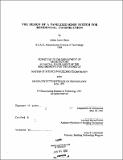The design of a panelized roof system for residential construction
Author(s)
Dentz, Jordan Lewis
DownloadFull printable version (15.43Mb)
Other Contributors
Massachusetts Institute of Technology. Dept. of Architecture.
Advisor
Leonard Morse-Fortier.
Terms of use
Metadata
Show full item recordAbstract
The cost of housing in the U.S. continues to rise faster than household income. Innovative building materials and construction technologies have the potential to reduce housing construction costs. One strategy to do this is componentization. There is a longstanding trend towards the increased use of components in U.S. residential construction. One such type of component is the composite building panel, used for walls, roofs and floors. Presently the types of composite panels used in residential construction include pre-framed walls of standard construction and, more innovatively, structural foam core panels with wood or wood composite faces. This thesis focuses on the design of a panelized roofing system for residential construction. The roof was chosen for various reasons. It includes some of the most complicated geometrical and structural challenges. It is often the most difficult area of the house to frame conventionally. Its construction is a crucial step in getting the house weather tight. For these reasons and others builders have identified it as a prime target for innovation. The design of the panelized roof system is illustrated as a tree of decisions. The path traveled down this tree led to a ribbed panel spanning from eave to ridge. A design selection method developed by Stuart Pugh was used to design the connection details of the system. The interdisciplinary design process used to design the roof system is examined and evaluated in light of the results it yielded. Mock-ups, models and a full scale proof-of-concept structure were built. These constructions were used as learning tools during design and to demonstrate and evaluate the performance of the roof system design.
Description
Thesis (M.S.)--Massachusetts Institute of Technology, Dept. of Architecture, 1991. Includes bibliographical references (p. 158-163).
Date issued
1991Department
Massachusetts Institute of Technology. Department of ArchitecturePublisher
Massachusetts Institute of Technology
Keywords
Architecture.